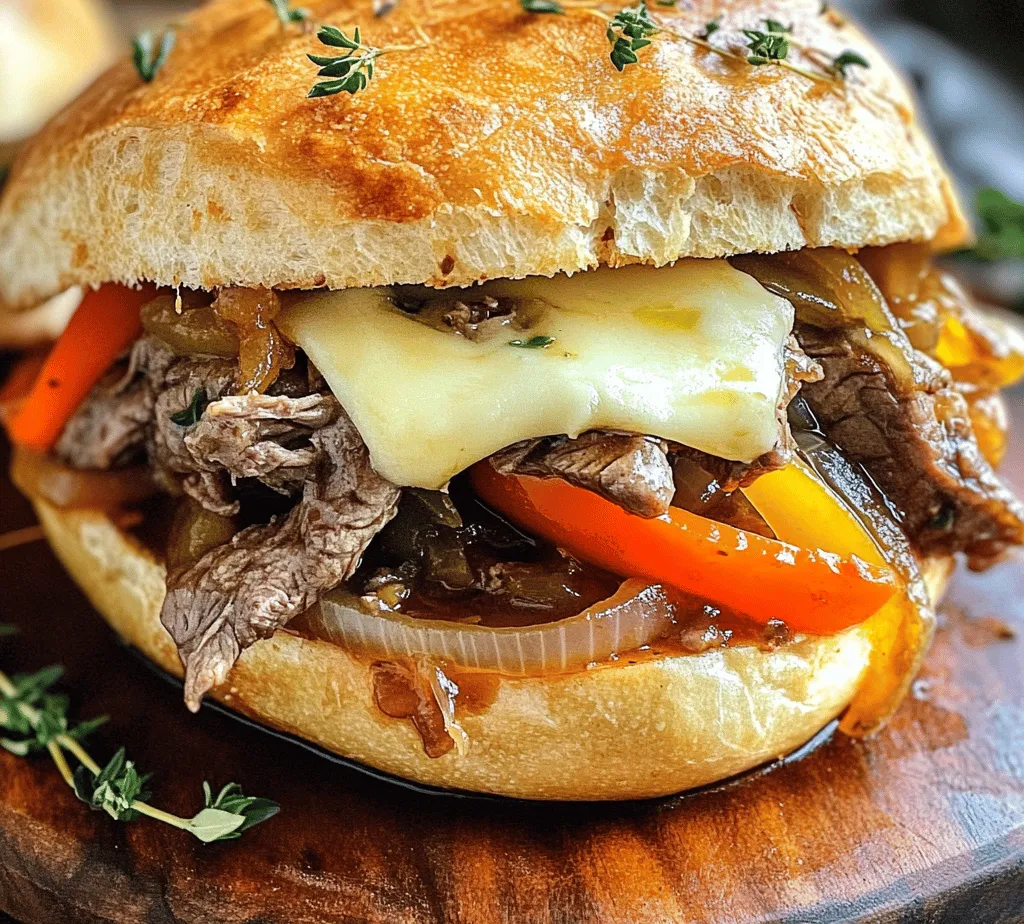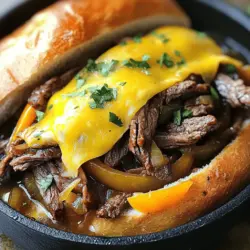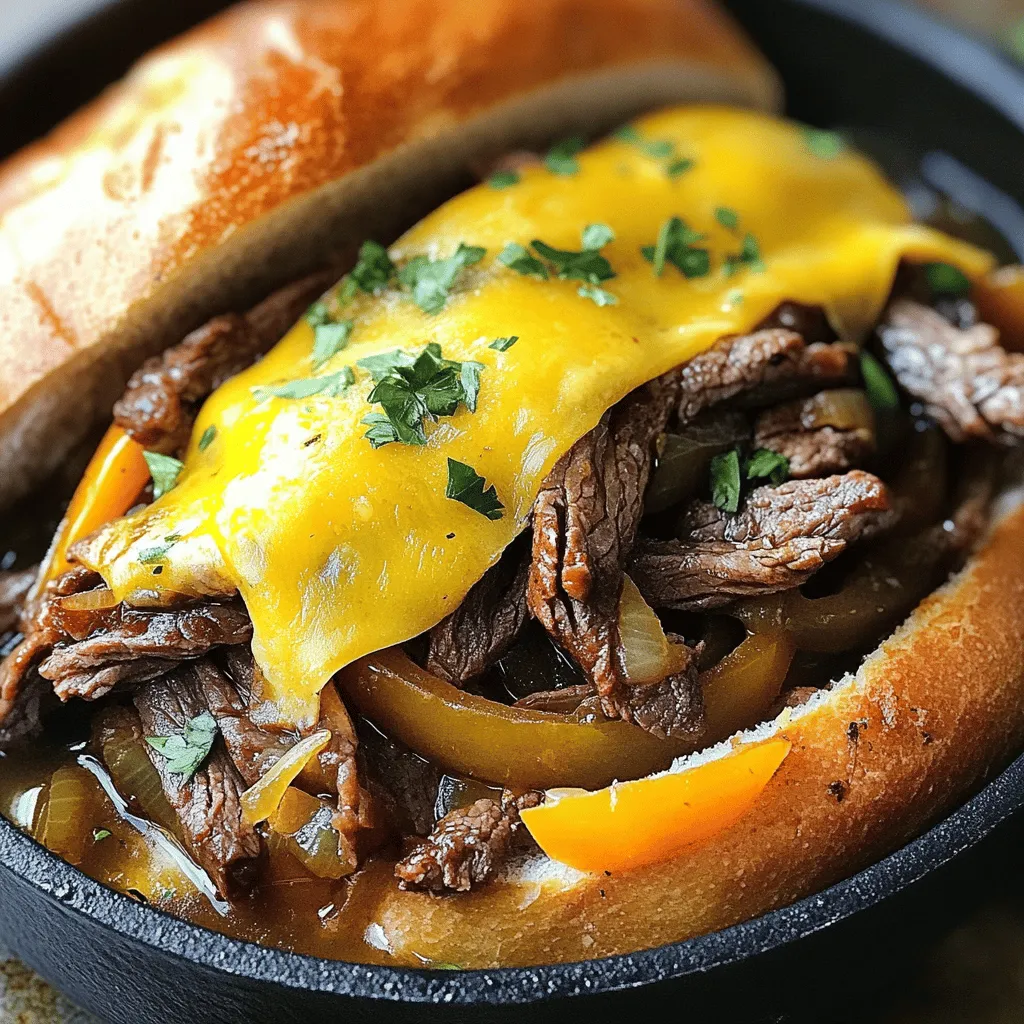Introduction
Few dishes evoke the same level of enthusiasm and comfort as the iconic Philly cheesesteak, a sandwich that has cemented its place in American culinary culture. Originating from Philadelphia, this beloved dish features thinly sliced beef, typically ribeye or flank steak, sautéed onions, and melted cheese, all served on a fresh hoagie roll. It’s not just a meal; it’s a cultural experience that brings people together over its hearty flavors and satisfying textures.
In recent years, the art of slow cooking has gained tremendous popularity, especially among home cooks who appreciate the depth of flavor that this method can impart. Slow cooking allows ingredients to meld beautifully, resulting in tender, juicy meats and rich, savory sauces. The crockpot stands out as a quintessential tool for busy lifestyles, enabling anyone to prepare mouthwatering meals with minimal effort. Just set it and forget it!
The Slow-Cooked Philly Cheesesteak Delight is perfect for gatherings, family dinners, or simply a cozy night in. This recipe takes all the classic components of a traditional Philly cheesesteak and transforms them into a sumptuous slow-cooked delight that promises to satisfy even the heartiest of appetites.
Understanding the Ingredients
To create an authentic and delicious Slow-Cooked Philly Cheesesteak Delight, it’s vital to understand the key components that make up this iconic dish. Each ingredient plays a crucial role in achieving the perfect balance of flavors and textures.
The Beef: Flank Steak
At the heart of every great cheesesteak is the beef. Flank steak is an excellent choice for this recipe due to its flavor and texture. It comes from the abdominal muscles of the cow and is known for its rich, beefy taste. When cooked slowly, flank steak becomes incredibly tender, allowing it to absorb the delicious juices and seasonings that surround it.
When selecting flank steak for your Slow-Cooked Philly Cheesesteak Delight, look for cuts that have a good amount of marbling. The intramuscular fat will render during the cooking process, enhancing the overall flavor and texture of the meat.
Fresh Vegetables: Onions and Bell Peppers
No Philly cheesesteak is complete without the addition of fresh vegetables. Onions are a staple ingredient, providing sweetness and depth to the dish. Green and red bell peppers add a pop of color and a mild crunch, complementing the tender beef and gooey cheese.
When preparing the vegetables, it’s essential to slice them evenly for uniform cooking. Cutting them into strips about the same size as the sliced beef will ensure that they cook at the same rate and help achieve that perfect bite.
Seasoning and Sauces
The significance of seasoning and sauces in enhancing the flavor of the Slow-Cooked Philly Cheesesteak Delight cannot be overstated. A blend of salt, pepper, and garlic powder will elevate the natural flavors of the meat and vegetables.
Additionally, consider incorporating a splash of Worcestershire sauce for a tangy kick and depth of flavor. For those who enjoy a bit of heat, a dash of crushed red pepper flakes can add a delightful spice that complements the savory notes of the dish.
Hoagie Rolls and Provolone Cheese
To complete the Philly cheesesteak experience, fresh hoagie rolls are a must. Look for rolls that are soft yet sturdy enough to hold the filling without falling apart.
Provolone cheese is the traditional choice for cheesesteaks, known for its mild, creamy flavor that melts beautifully over the hot ingredients. Feel free to experiment with other cheese varieties, such as mozzarella or cheddar, but for an authentic experience, stick with provolone.
Preparation Steps for Slow-Cooked Philly Cheesesteak Delight
Now that we’ve covered the essential ingredients, let’s delve into the preparation steps that will guide you in creating this delicious dish.
Preparing the Beef
Start by preparing the flank steak. Rinse the meat under cold water and pat it dry with paper towels. This step is crucial as it removes any excess moisture, allowing for better browning during cooking.
Next, trim any visible fat from the flank steak, but be careful not to remove too much, as some fat is necessary for flavor. Once trimmed, slice the beef against the grain into thin strips. This technique ensures that the meat remains tender after cooking.
Choosing the Right Flank Steak
When shopping for flank steak, look for a cut that is bright red with minimal discoloration. The texture should be firm, and the meat should have a good amount of marbling for optimal flavor. If you’re unsure, don’t hesitate to ask your butcher for recommendations on the best cut for slow cooking.
Importance of Seasoning
Generously season the sliced flank steak with salt, pepper, and garlic powder. This seasoning mix will permeate the meat as it cooks, enhancing its natural flavors.
Layering the Vegetables in the Crockpot
When it comes to layering ingredients in your crockpot, the order matters. Start by placing the sliced onions at the bottom, followed by the sliced green and red bell peppers.
The reason for this layering is that the onions will release moisture as they cook, helping to create a flavorful base that infuses the beef and peppers.
Cooking Vegetables with the Meat
Adding the vegetables at the same time as the meat has its benefits. Not only do the flavors meld together, but the vegetables also release their natural sweetness, contributing to the overall taste of the dish.
Slicing Vegetables for Even Cooking
For even cooking, slice the onions and bell peppers into strips about the same thickness as the beef. This ensures that everything cooks evenly, resulting in a harmonious blend of flavors and textures in each bite.
Adding the Beef and Broth Mixture
Now it’s time to add the seasoned beef to the crockpot on top of the layered vegetables. Spread it evenly to ensure that every piece of meat gets the chance to absorb the flavors from the broth and seasonings.
Next, pour in the beef broth. This liquid will serve two primary purposes: it helps to keep the beef moist during the slow cooking process, and it creates a sauce that will coat the meat and vegetables, making every bite delectable.
Explanation of the Broth’s Role
The broth is crucial for developing a rich, savory sauce that enhances the overall flavor of the Slow-Cooked Philly Cheesesteak Delight. As the dish cooks, the broth will reduce and concentrate, enveloping the beef and vegetables in a deliciously seasoned sauce that’s perfect for soaking into the hoagie rolls.
Suggestions for Alternative Broth Options
While beef broth is the traditional choice, there are several alternatives to consider. For a deeper flavor profile, you might use homemade beef stock or even a combination of beef broth and chicken broth.
For a more adventurous twist, consider using a beer-based broth, which can add unique flavors and enhance the overall richness of the dish. Just be sure to choose a beer that you enjoy drinking, as the flavors will concentrate during cooking.
With these preparation steps complete, your Slow-Cooked Philly Cheesesteak Delight is set to transform into a culinary masterpiece that’s perfect for any occasion. As you move forward, the anticipation of savoring this comforting dish will surely have your taste buds tingling with excitement.

Cooking Process and Tips for Success
When it comes to slow cooking, timing and temperature are crucial for creating the perfect Slow-Cooked Philly Cheesesteak Delight. This dish requires a patient approach, allowing the flavors to meld beautifully while ensuring the beef becomes tender and juicy.
Overview of Cooking Times and Settings for the Crockpot
For this recipe, the ideal cooking time in a crockpot is between 6 to 8 hours on low or 3 to 4 hours on high. The low and slow method allows the beef to break down gradually, absorbing the flavors from the peppers, onions, and broth, which results in a rich and hearty filling. However, if you’re pressed for time, the high setting will still yield delicious results, albeit with a slightly different texture.
Comparison of Low and High Cooking Methods
Cooking on low allows for a more gradual infusion of flavors, resulting in a tender beef that practically melts in your mouth. This method is particularly beneficial for tougher cuts of meat, such as chuck roast, which is ideal for cheesesteaks. On the other hand, cooking on high speeds up the process, making it a suitable option for busy weeknights. However, keep in mind that the beef may not achieve the same level of tenderness as it would with a longer, low cook.
Insights on How Cooking Time Affects Flavor and Texture
The cooking time directly influences the depth of flavor in your Slow-Cooked Philly Cheesesteak Delight. The longer the ingredients simmer together, the more they will marry, creating a harmonious balance of taste. As the beef cooks, its natural juices are released, mingling with the broth and seasoning, which enhances the overall flavor profile. The vegetables also soften and impart their sweetness, making every bite satisfying.
Monitoring the Cooking Process
While the crockpot does much of the work for you, it’s important to periodically check on your dish, especially if you’re trying a new cooking time or temperature. The goal is to achieve a balance where the beef is tender yet retains its structure for the sandwich. If you notice the beef becoming too soft, consider reducing the cooking time next time.
Discussing the Importance of Tenderness in Beef
Tenderness is paramount when it comes to a great cheesesteak. You want to be able to pull the beef apart easily with a fork, which is a sign that it has been cooked perfectly. If you find that your beef is still tough after the recommended cooking time, it may require a bit more time in the crockpot. A general rule of thumb is that if the meat is not shredding easily, it needs a little more love and heat.
How to Know When the Dish is Ready
Your Slow-Cooked Philly Cheesesteak Delight is ready when the beef is fork-tender and the flavors have fully developed. Check the beef with a fork; if it shreds easily, it’s done. Additionally, the vegetables should be soft but not mushy, adding just the right amount of texture to the filling.
Serving Suggestions
Once your Slow-Cooked Philly Cheesesteak Delight is ready, the next step is to assemble it into delicious hoagies that are sure to impress.
Step-by-Step Guide to Assembling the Hoagie Rolls
1. Prepare the Rolls: Start with fresh hoagie rolls or sub sandwich buns. Lightly toast them in the oven for a few minutes to give them a slight crunch and help them hold up against the filling.
2. Portioning the Beef and Vegetable Mixture: Using a slotted spoon, scoop the beef and vegetable mixture from the crockpot. This will help drain excess liquid, ensuring your sandwich doesn’t become soggy. Aim for a generous portion, filling each hoagie roll about three-quarters full.
3. Cheese Melt for Flavor and Texture: The crowning glory of any cheesesteak is, of course, the cheese. Traditional options include provolone, Cheez Whiz, or even mozzarella. Place a slice of cheese over the beef mixture while it’s still hot, allowing it to melt beautifully into the filling.
Optional Broiling for an Extra Layer of Flavor
For those who want to elevate their cheesesteak, consider finishing it under the broiler.
1. Description of the Broiling Process and Its Benefits: After assembling your hoagies, place them on a baking sheet and broil them for 2-3 minutes. This will not only melt the cheese but also give the tops a delightful golden-brown color and a crispy texture that contrasts perfectly with the soft interior.
2. Ideas for Side Dishes that Complement the Cheesesteak: Serve your cheesesteaks with classic sides such as crispy fries, onion rings, or a fresh garden salad. A side of pickles or coleslaw can also add a refreshing crunch that balances the richness of the sandwich.
Nutritional Information
Understanding the nutritional aspects of your Slow-Cooked Philly Cheesesteak Delight can help you make informed choices about your meal.
Breakdown of Nutritional Values per Serving
A typical serving of this cheesesteak (with a hoagie roll and cheese) contains approximately:
– Calories: 550-650 calories (depending on the cheese and roll used)
– Protein: 35-40 grams
– Fat: 20-30 grams
– Carbohydrates: 50-60 grams
Discussion on the Balance of Protein, Fats, and Carbohydrates in the Dish
This dish offers a satisfying balance of protein from the beef and cheese, healthy fats, and carbohydrates from the hoagie roll. The protein content is particularly high, making it a filling option for a hearty meal.
Suggestions for Modifying the Recipe for Dietary Preferences
If you’re looking to adapt the recipe, here are some options:
– Gluten-Free Rolls: Substitute traditional hoagie rolls for gluten-free alternatives to accommodate gluten sensitivities.
– Vegetarian Options: For a vegetarian version, consider using sautéed mushrooms, eggplant, or a meat substitute like tempeh or seitan to capture the essence of a cheesesteak without the meat.
Conclusion
The Slow-Cooked Philly Cheesesteak Delight is not only an easy and satisfying recipe but also a comforting dish that can become a staple in your meal planning. The slow cooking process allows the flavors to develop, while the tender beef and melted cheese create an irresistible filling for your hoagie rolls.
This recipe brings a classic comfort food experience to the forefront, perfect for family dinners or game day gatherings. Don’t hesitate to experiment with different cheeses, toppings, or side dishes to make it your own. With every bite, you’ll appreciate the rich flavors and the joy of sharing a meal that has the potential to become a family favorite.



